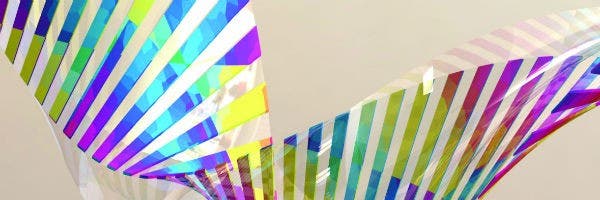It’s awesome when engineers can take inspiration from nature and design something truly spectacular – and useful. Now, a Berkeley team has managed to create a material that can shift colors as easy as a chameleon’s skin when pulled or twisted. The material could be used for camouflage or for the next generation of display technologies.

The Optical Society
“This is the first time anybody has made a flexible chameleon-like skin that can change color simply by flexing it,” said Connie J. Chang-Hasnain, a member of the UC Berkeley team that published a paper on the technology this week in the journal Optica.
The approach they used was physical, as they didn’t tamper with the chemical make-up of the material. Instead of using chemical dyes or pigments to absorb and reflect light in a different way, thus changing colors, engineers manipulated the structure of a silicon film about a thousand times thinner than a human hair (120 nm). They carved rows of tiny ridges — each smaller than a wavelength of light — onto the film, at different wavelengths. Each color has its own specific wavelength, and each of the small carvings is designed to reflect a very specific wavelength, and therefore its corresponding color. The study leader explains:
“If you have a surface with very precise structures, spaced so they can interact with a specific wavelength of light, you can change its properties and how it interacts with light by changing its dimensions,” said Chang-Hasnain.
This is called structural color. Structural coloration is the production of colour by microscopically structured surfaces, also called schemochromes, fine enough to interfere with visible light without the need of pigments. This type of coloration is present in several types of birds and beetles. But rather than reflecting the entire rainbow, the researchers “tuned” the space between the bars to achieve specific colors.
The approach itself is not entirely new. In astronomy, for example, evenly spaced slits known as diffraction gratings are routinely used to direct light and spread it into its component colors. However, efforts to actually control this technique have remained futile and earlier efforts to develop a flexible, color shifting surface failed in a number of aspects. The Berkeley researchers were able to overcome these problems by using a semiconductor layer of silicon approximately 120 nanometers thick, embedding the silicon bars into a flexible layer of silicone. As the silicone was bent or flexed, the period of the grating spacings responded in kind.
The next step would be to create a proof-of-concept large enough for commercial applications.
“The next step is to make this larger-scale and there are facilities already that could do so,” said Chang-Hasnain. “At that point, we hope to be able to find applications in entertainment, security, and monitoring.”
Aside for being used for camouflage or display technologies, this could also be developed into a sensor that indicates structural fatigue and stress for buildings and bridges.
“This is the first time anyone has achieved such a broad range of color on a one-layer, thin and flexible surface,” concluded Change-Hasnain. “I think it’s extremely cool.”
Indeed it is, sir. Indeed it is.
Journal Reference: Li Zhu, Jonas Kapraun, James Ferrara, and Connie J. Chang-Hasnain. Flexible photonic metastructures for tunable coloration. http://dx.doi.org/10.1364/OPTICA.2.000255


